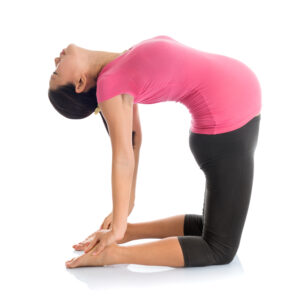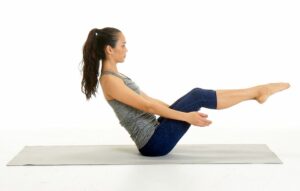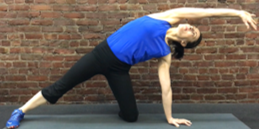Core Exercises to Avoid During Pregnancy

Understanding what “basic exercises to avoid” are one of the most common questions asked during pregnancy. So, this post will guide you through a simple rubric that will help you make smarter choices about what core exercises are right for you and reduce the fear that tends to accompany prenatal core work.
That said, before we get into what to do avoid, we want to emphasize the importance of building and maintaining a strong core to withstand the stresses of pregnancy and childbirth, and recover more quickly afterwards. For help doing this, see #1 most effective core exercise and 12 moves to build core strength.
Of course, we understand that knowing what to avoid doing is an important part of the prenatal training puzzle, so let’s get into that now. We’ll start with a brief explanation of the major changes that occur in your core during pregnancy so you can appreciate the why behind our recommendations, and tailor our guide to your specific situation.
How Pregnancy Affects Your Core
The two biggest contributors to your major prenatal changes are the increase in intra-abdominal pressure (IAP) and the changes your alignment. Let’s talk about each other.
1. Increased Intra-Abdominal Pressure (IAP).
When a body gains weight during pregnancy, it is mainly concentrated in the abdominal cavity. This added mass increases the pressure in that cavity, or intra-abdominal pressure (IAP). The increased pressure drives out into the abdominal wall, making the left and right sides of rectus abdominis (or “6-pack” muscle) is even more spread out. You can see it in the right picture below.
This “widening” of the space between the left and right sides of the rectus abdominis muscle is known as Diastasis Recti (DR). A certain value of DR is a normal and necessary part of pregnancy to make room for the growing baby. However, it is important to reduce those activities additional raise this pressure, as DR can be more difficult to heal in the postpartum period. So, that’s where some of our key exercise modifications come in.
2. Alignment Shifts
Another factor that affects core exercise changes is that a growing belly tends to tip one’s pelvis forward — as you can see in the photo below — which puts pressure on the tissues of the low back (ouch! ) and stretching the abdominal tissues (which already have stress on them from the increased IAP we just discussed). It becomes compound as the weight increases.


Key Exercises to Avoid and Modify
The stresses discussed above come as a result of the growing belly. Therefore, major changes in exercise begin almost as soon as you develop a stomach. The goal is to stay strong while being smart about your exercise choices so as not to put on weight additional stress your core. Here are some general guidelines to help you do this. Once you develop a stomach, start to avoid the following types of movements:
- Spinal flexion (crunching): Sit-ups and crunches are obvious examples, as well as any other forward rounding that targets the abdominal muscles.


- Lateral flexion: Just as forward bending increases pressure on the core, so does side-to-side bending.


- Extension of the spine (arching): Deep stretches such as upward dog and backbends stretch the abdominal tissue (between the left and right sides of the rectus abdominus muscle) too much and can further widen the gap.


- Turning: This means turning to separation of hips and shoulders (Hips move one way, shoulders move the opposite). Rotating your hips and shoulders in line — where your entire trunk moves as a unit — is completely safe do throughout pregnancy. For further clarification, see Spin Dos and Don’ts.


- Full boards (edit): Most people will probably need to start changing to full planks when they have a medium-sized stomach — especially center planks that put direct downward pressure on the stomach. There are two main signs that indicate the need to regress: 1) loss of neutral alignment (missing the straight line between ear-shoulder-hip-knee-ankle, as you can see in this picture — eeek!) and 2) “coning” in the abdomen (see “important notes” below). You can modify planks by performing them on your knees or on an incline. Once you have a big belly, we highly recommend it avoiding the entire center planksbecause the direct downward pressure on the stomach is very good.


- Advanced back-lying or incline core work: Many basic exercises performed on your back or on an incline – such as the “Pilates 100s” and V-sit shown below – do not involve any crunching, arching, bending, or twisting, but they still create excess that IAP because of the level of stress they put on the abdominal muscles. Therefore, they should also be avoided.




- Shortness of breath due to fatigue: This last one is not an “exercise,” but rather a behavior to avoid. Breath holding on exertion is also known as the Valsalva maneuver, and it’s mostly used by heavy lifters (as you’ll see below). Holding your breath during exertion increases the pressure within your core, which doing resulting in greater force production. However, this has the side effect of putting too much pressure on the abdominal wall and pelvic floor, which can exacerbate issues with Diastasis Recti (DR) and Pelvic Floor Dysfunction (PFD). Remember, this is why DRs and PFDs are common among powerlifters, and others who lift very heavy loads. Another example of holding the breath during exertion is “going down” on the toilet during a difficult bowel movement.




Unfortunately, constipation is common during pregnancy, due to some of the hormonal changes. For tips on reducing constipation, check out this post on 10 tips to reduce pregnancy stiffness. Instead of breathing in persistence, a safer way to generate force is the exhale with exertion (watch a video demo).
***2 Important Notes***
It is important to clarify two points about the above recommendations.
1. Changes are for “loaded” moves (unloaded is fine): For all the exercises above, we talk full motion (strengthening training) or very deep stretches (as in upward dog). uloaded movements in these positions, or gentle stretches — like the cat-cow stretch or side kneeling shown below — are ideal.




2. Watch the “coning” in your stomach: It is impossible to give a list of black and white “rules” that apply to every single person. Therefore, we provide the best general guidance we can, but it’s up to you to make the best decisions for your body — based on your activity history, belly size, condition, etc. A very useful tool to use is tracking coning or a vertical torpedo-like bulge that protrudes down the middle of your abdomen, as shown below. This is a sign that movement is being made exceed the capacity of the core muscles at that time. If you see it — at any point (not only during pregnancy) – stop moving, and regress (take down) until you can no longer see the coning. This can be very useful for determining when you need to start regressing exercises like planks.




Additional Resources
For guidelines on other movements to avoid or modify, download our FREE Guide: Moves to Avoid by Trimester.
Looking for guidance on what to do focus on? Explore our prenatal self-guided training programs. These programs lead you through a safe and effective training program — tailored to your stage — to help you prepare your body for pregnancy, childbirth, and the physical demands of early parenthood, and recover faster. Or, for more personalized coaching, consider working with a PROnatal Personal Trainer.
Finally, if you are a health and fitness professional interested in working with pre and postnatal clients, explore our pre & postnatal professional education. We offer a variety of courses tailored to the needs of both personal trainers and group fitness instructors.





